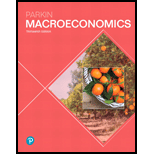
Macroeconomics
13th Edition
ISBN: 9780134744452
Author: PARKIN, Michael
Publisher: Pearson,
expand_more
expand_more
format_list_bulleted
Question
Chapter 9, Problem 3SPA
To determine
Determine the value of 100 yen in terms of the U.S. dollar in different periods and identify if the yen appreciates or
Expert Solution & Answer
Want to see the full answer?
Check out a sample textbook solution
Students have asked these similar questions
You are the manager of a large automobile dealership who wants to learn more about the effective-
ness of various discounts offered to customers over the past 14 months. Following are the average
negotiated prices for each month and the quantities sold of a basic model (adjusted for various
options) over this period of time.
1. Graph this information on a scatter plot. Estimate the demand equation. What do the
regression results indicate about the desirability of discounting the price? Explain.
Month
Price
Quantity
Jan.
12,500
15
Feb.
12,200
17
Mar.
11,900
16
Apr.
12,000
18
May
11,800
20
June
12,500
18
July
11,700
22
Aug.
12,100
15
Sept.
11,400
22
Oct.
11,400
25
Nov.
11,200
24
Dec.
11,000
30
Jan.
10,800
25
Feb.
10,000
28
2. What other factors besides price might be included in this equation? Do you foresee any
difficulty in obtaining these additional data or incorporating them in the regression analysis?
simple steps on how it should look like on excel
Consider options on a stock that does not pay dividends.The stock price is $100 per share, and the risk-free interest rate is 10%.Thestock moves randomly with u=1.25and
d=1/u
Use Excel to calculate the premium of a10-year call with a strike of $100.
Chapter 9 Solutions
Macroeconomics
Ch. 9.1 - Prob. 1RQCh. 9.1 - Prob. 2RQCh. 9.1 - Prob. 3RQCh. 9.1 - Prob. 4RQCh. 9.1 - Prob. 5RQCh. 9.1 - Prob. 6RQCh. 9.1 - Prob. 7RQCh. 9.2 - Prob. 1RQCh. 9.2 - Prob. 2RQCh. 9.2 - Prob. 3RQ
Ch. 9.2 - Prob. 4RQCh. 9.2 - Prob. 5RQCh. 9.2 - Prob. 6RQCh. 9.3 - Prob. 1RQCh. 9.3 - Prob. 2RQCh. 9.3 - Prob. 3RQCh. 9.3 - Prob. 4RQCh. 9.4 - Prob. 1RQCh. 9.4 - Prob. 2RQCh. 9.4 - Prob. 3RQCh. 9 - Prob. 1SPACh. 9 - Prob. 2SPACh. 9 - Prob. 3SPACh. 9 - Prob. 4SPACh. 9 - Prob. 5SPACh. 9 - Prob. 6SPACh. 9 - Prob. 7SPACh. 9 - Prob. 8SPACh. 9 - Prob. 9SPACh. 9 - Prob. 10SPACh. 9 - Prob. 11APACh. 9 - Prob. 12APACh. 9 - Prob. 13APACh. 9 - Prob. 14APACh. 9 - Prob. 15APACh. 9 - Prob. 16APACh. 9 - Prob. 17APACh. 9 - Prob. 18APACh. 9 - Prob. 19APACh. 9 - Prob. 20APACh. 9 - Prob. 21APACh. 9 - Prob. 22APACh. 9 - Prob. 23APACh. 9 - Prob. 24APACh. 9 - Prob. 25APACh. 9 - Prob. 26APACh. 9 - Prob. 27APACh. 9 - Prob. 28APACh. 9 - Prob. 29APA
Knowledge Booster
Similar questions
- Please solve this, no words or explanations.arrow_forward17. Given that C=$700+0.8Y, I=$300, G=$600, what is Y if Y=C+I+G?arrow_forwardUse the Feynman technique throughout. Assume that you’re explaining the answer to someone who doesn’t know the topic at all. Write explanation in paragraphs and if you use currency use USD currency: 10. What is the mechanism or process that allows the expenditure multiplier to “work” in theKeynesian Cross Model? Explain and show both mathematically and graphically. What isthe underpinning assumption for the process to transpire?arrow_forward
- Use the Feynman technique throughout. Assume that you’reexplaining the answer to someone who doesn’t know the topic at all. Write it all in paragraphs: 2. Give an overview of the equation of exchange (EoE) as used by Classical Theory. Now,carefully explain each variable in the EoE. What is meant by the “quantity theory of money”and how is it different from or the same as the equation of exchange?arrow_forwardZbsbwhjw8272:shbwhahwh Zbsbwhjw8272:shbwhahwh Zbsbwhjw8272:shbwhahwhZbsbwhjw8272:shbwhahwhZbsbwhjw8272:shbwhahwharrow_forwardUse the Feynman technique throughout. Assume that you’re explaining the answer to someone who doesn’t know the topic at all:arrow_forward
- Use the Feynman technique throughout. Assume that you’reexplaining the answer to someone who doesn’t know the topic at all: 4. Draw a Keynesian AD curve in P – Y space and list the shift factors that will shift theKeynesian AD curve upward and to the right. Draw a separate Classical AD curve in P – Yspace and list the shift factors that will shift the Classical AD curve upward and to the right.arrow_forwardUse the Feynman technique throughout. Assume that you’re explaining the answer to someone who doesn’t know the topic at all: 10. What is the mechanism or process that allows the expenditure multiplier to “work” in theKeynesian Cross Model? Explain and show both mathematically and graphically. What isthe underpinning assumption for the process to transpire?arrow_forwardUse the Feynman technique throughout. Assume that you’re explaining the answer to someone who doesn’t know the topic at all: 15. How is the Keynesian expenditure multiplier implicit in the Keynesian version of the AD/ASmodel? Explain and show mathematically. (note: this is a tough one)arrow_forward
arrow_back_ios
SEE MORE QUESTIONS
arrow_forward_ios
Recommended textbooks for you
 Macroeconomics: Private and Public Choice (MindTa...EconomicsISBN:9781305506756Author:James D. Gwartney, Richard L. Stroup, Russell S. Sobel, David A. MacphersonPublisher:Cengage Learning
Macroeconomics: Private and Public Choice (MindTa...EconomicsISBN:9781305506756Author:James D. Gwartney, Richard L. Stroup, Russell S. Sobel, David A. MacphersonPublisher:Cengage Learning Economics: Private and Public Choice (MindTap Cou...EconomicsISBN:9781305506725Author:James D. Gwartney, Richard L. Stroup, Russell S. Sobel, David A. MacphersonPublisher:Cengage Learning
Economics: Private and Public Choice (MindTap Cou...EconomicsISBN:9781305506725Author:James D. Gwartney, Richard L. Stroup, Russell S. Sobel, David A. MacphersonPublisher:Cengage Learning Economics (MindTap Course List)EconomicsISBN:9781337617383Author:Roger A. ArnoldPublisher:Cengage Learning
Economics (MindTap Course List)EconomicsISBN:9781337617383Author:Roger A. ArnoldPublisher:Cengage Learning



Macroeconomics: Private and Public Choice (MindTa...
Economics
ISBN:9781305506756
Author:James D. Gwartney, Richard L. Stroup, Russell S. Sobel, David A. Macpherson
Publisher:Cengage Learning

Economics: Private and Public Choice (MindTap Cou...
Economics
ISBN:9781305506725
Author:James D. Gwartney, Richard L. Stroup, Russell S. Sobel, David A. Macpherson
Publisher:Cengage Learning

Economics (MindTap Course List)
Economics
ISBN:9781337617383
Author:Roger A. Arnold
Publisher:Cengage Learning


